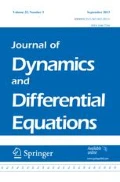Abstract
In this paper, we prove an abstract KAM (Kolmogorov–Arnold–Moser) theorem for infinite dimensional reversible Schrödinger systems. Using this KAM theorem together with partial Birkhoff normal form method, we obtain the existence of quasi-periodic solutions for a class of completely resonant reversible coupled nonlinear Schrödinger systems on two dimensional torus.
Similar content being viewed by others
Notes
The norm of vector valued function \(G:D_\rho (r,s)\times {\mathcal {O}}\rightarrow {\mathbb {C}}^b\), \(b<\infty ,\) is defined as \(\Vert G\Vert _{D_\rho (r,s)\times {\mathcal {O}}}=\mathop {\sum }\nolimits ^b_{a=1}\Vert G_a\Vert _{D_\rho (r,s)\times {\mathcal {O}}}\).
References
Berti, M., Bolle, P.: Sobolev quasi-periodic solutions of multidimensional wave equations with a multiplicative potential. Nonlinearity 25(9), 2579–2613 (2012)
Berti, M., Bolle, P.: Quasi-periodic solutions with Sobolev regularity of NLS on \(\mathbb{T}^d\) with a multiplicative potential. J. Eur. Math. Soc. (JEMS) 15(1), 229–286 (2013)
Berti, M., Corsi, L., Procesi, M.: An abstract Nash–Moser theorem and quasi-periodic solutions for NLW and NLS on compact Lie groups and homogeneous manifolds. Commun. Math. Phys. 334(3), 1413–1454 (2015)
Bourgain, J.: Construction of quasi-periodic solutions for Hamiltonian perturbations of linear equations and applications to nonlinear PDE. Int. Math. Res. Not. 11, 475ff (1994)
Bourgain, J.: Quasi-periodic solutions of Hamiltonian perturbations of 2D linear Schrödinger equations. Ann. Math. (2) 148(2), 363–439 (1998)
Bourgain, J.: Green’s Function Estimates for Lattice Schrödinger Operators and Applications. Annals of Mathematics Studies, vol. 158. Princeton University Press, Princeton (2005)
Bourgain, J., Wang, W.: Quasi-periodic solutions of nonlinear random Schrödinger equations. J. Eur. Math. Soc. (JEMS) 10(1), 1–45 (2008)
Chierchia, L., You, J.: KAM tori for 1D nonlinear wave equations with periodic boundary conditions. Commun. Math. Phys. 211(2), 497–525 (2000)
Eliasson, L., Grébert, B., Kuksin, S.: KAM for the nonlinear beam equation. Geom. Funct. Anal. 26(6), 1588–1715 (2016)
Eliasson, L., Kuksin, S.: KAM for the nonlinear Schrödinger equation. Ann. Math. (2) 172(1), 371–435 (2010)
Ge, C., Geng, J., Lou, Z.: KAM tori for reversible derivative beam equations on \(\mathbb{T}^2\). Math. Z. (2020). https://doi.org/10.1007/s00209-020-02575-9
Geng, J., Xu, X., You, J.: An infinite dimensional KAM theorem and its application to the two dimensional cubic Schrödinger equation. Adv. Math. 226(6), 5361–5402 (2011)
Geng, J., You, J.: KAM tori for higher dimensional beam equations with constant potentials. Nonlinearity 19(10), 2405–2423 (2006)
Geng, J., You, J.: A KAM theorem for higher dimensional nonlinear Schrödinger equations. J. Dyn. Differ. Equ. 25(2), 451–476 (2013)
Geng, J., Xue, S.: Invariant tori for two-dimensional nonlinear Schrödinger equations with large forcing terms. J. Math. Phys. 60, 052703 (2019)
Grébert, B., Vilaça Da Rocha, V.: Stable and unstable time quasi periodic solutions for a system of coupled NLS equations. Nonlinearity 31, 4776 (2018)
Kuksin, S.: Hamiltonian perturbations of infinite-dimensional linear systems with imaginary spectrum. Funktsional. Anal. i Prilozhen. 21(3), 22–37, 95 (1987)
Kuksin, S., Pöschel, J.: Invariant Cantor manifolds of quasi-periodic oscillations for a nonlinear Schrödinger equation. Ann. Math. (2) 143(1), 149–179 (1996)
Newell, A., Moloney, J.: Nonlinear Optics. Advanced Topics in the Interdisciplinary Mathematical Sciences. Addison-Wesley Publishing Company, Advanced Book Program, Redwood City, CA (1992)
Pöschel, J.: On elliptic lower-dimensional tori in Hamiltonian systems. Math. Z. 202(4), 559–608 (1989)
Pöschel, J.: A KAM-theorem for some nonlinear partial differential equations. Ann. Scuola Norm. Sup. Pisa Cl. Sci. (4) 23(1), 119–148 (1996)
Procesi, C., Procesi, M.: A KAM algorithm for the resonant non-linear Schrödinger equation. Adv. Math. 272, 399–470 (2015)
Procesi, M., Xu, X.: Quasi-Töplitz functions in KAM theorem. SIAM J. Math. Anal. 45(4), 2148–2181 (2013)
Sun, Y., Lou, Z., Geng, J.: A KAM theorem for higher dimensional reversible nonlinear Schrödinger equations. Preprint (2017)
Wang, W.: Energy supercritical nonlinear Schrödinger equations: quasiperiodic solutions. Duke Math. J. 165(6), 1129–1192 (2016)
Wang, W.: Quasi-Periodic Solutions for Nonlinear Klein–Gordon Equations. arXiv:1609.00309 (2017)
Wayne, C.: Periodic and quasi-periodic solutions of nonlinear wave equations via KAM theory. Commun. Math. Phys. 127(3), 479–528 (1990)
Acknowledgements
We would like to thank anonymous referee for helping to improve this paper. The research was supported by the National Natural Science Foundation of China (NSFC) (Grant No. 11971012). Z. Lou was supported by NSFC (Grant No. 11901291) and the Natural Science Foundation of Jiangsu Province, China (Grant No. BK20190395). Y. Sun was supported by the China Scholarship Council (CSC) (Grant No. 202006190134).
Author information
Authors and Affiliations
Corresponding author
Additional information
Publisher's Note
Springer Nature remains neutral with regard to jurisdictional claims in published maps and institutional affiliations.
Appendix
Appendix
Suppose vector field \(X(\theta , I, z, {\bar{z}})\) is defined on \(D_\rho (r,s)=\{y=(\theta , I, z, {\bar{z}}):|Im \theta |<r,\, |I|<s,\, \Vert z\Vert _{\rho }<s,\, \Vert {\bar{z}}\Vert _{\rho }<s\}.\)
Definition 6.1
(Reversible vector field) Suppose S is an involution map: \(S^2=id.\) Vector field X is called reversible with respect to S (or S-reversible), if
i.e.,
where DS is the tangent map of S.
Definition 6.2
Suppose S is an involution map: \(S^2=id.\) Vector field X is called invariant with respect to S (or S-invariant), if
Definition 6.3
A transformation \(\Phi \) is called invariant with respect to above involution S (or S-invariant), if \(\Phi \circ S=S\circ \Phi .\)
Lemma 6.1
-
(1)
If X and Y are both S-reversible (or S-invariant), then [X, Y] is S-invariant.
-
(2)
If X is S-reversible, Y is S-invariant and the transformation \(\Phi \) is S-invariant, then [X, Y] and \(\Phi ^*{X}\) are both S-reversible. In particular, the flow \(\phi _{Y} ^t\) of Y are S-invariant, thus \((\phi _{Y} ^t)^*{X}\) is S-reversible.
Lemma 6.2
(Cauchy’s inequality, [14]) Let \(0<\delta <r.\) For an analytic function \(f(\theta , I, z, {\bar{z}})\) on \(D_\rho (r,s),\)
and
Rights and permissions
About this article
Cite this article
Geng, J., Lou, Z. & Sun, Y. A KAM Theorem for Two Dimensional Completely Resonant Reversible Schrödinger Systems. J Dyn Diff Equat 35, 1611–1641 (2023). https://doi.org/10.1007/s10884-021-09941-z
Received:
Revised:
Accepted:
Published:
Issue Date:
DOI: https://doi.org/10.1007/s10884-021-09941-z


